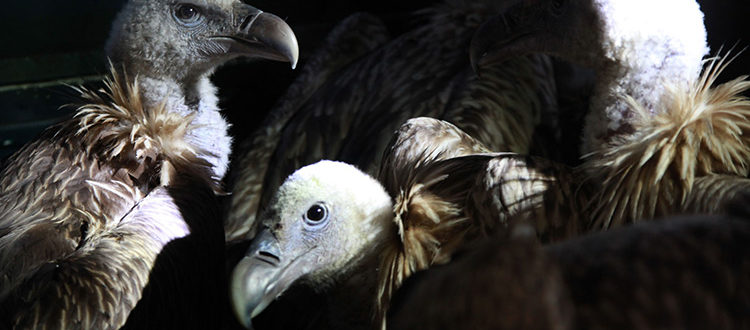Successfully Treated at CWRC for Poisoning, Ten Himalayan Griffon Vultures Sent Back to the Wild
[acx_slideshow name=”CWRC Poisoned Vultures 06042018″]
CWRC, Assam, April 6, 2018: Ten Himalayan Griffon vultures (Gyps himalayensis) that had undergone treatment at CWRC (the Centre for Wildlife Rehabilitation and Conservation, IFAW-WTI and the Assam Forest Department’s wildlife rescue, treatment and rehabilitation facility near Kaziranga National Park) for ingestion of poisoned meat were released into their home range in Laokhowa Wildlife Sanctuary yesterday morning.
As reported earlier, frontline forest staff had found 26 comatose and dead vultures near Laokhowa’s Palashtoli anti-poaching camp on March 25. The CWRC Mobile Veterinary Service (MVS) team was called in and 12 surviving vultures were transported to the centre following emergency in situ treatment, though two vultures succumbed to the poison en route. The ten surviving vultures were placed in isolation at the centre and closely monitored by IFAW-WTI veterinarians Dr Panjit Basumatary, Dr Samshul Ali and Dr Santosh Kumar Gupta.
IFAW-WTI and the Assam Forest Department also conducted awareness meetings in fringe villages of Laokhowa WLS to sensitise local communities about the ecological importance of vultures
“A clinical examination has confirmed that the death of Himalayan Griffon vultures in this incident occurred due carcass poisoning”, said Dr Ali, who had led the MVS team that attended the case. “There is an ill practice in many villages on the fringes of Protected Areas in Assam, wherein a carcass is poisoned to kill dogs and wild carnivores. Vultures that consume the poisoned meat often die in such incidents.”
Yesterday morning, with the CWRC veterinarians having given their assent, the vultures were transported to a field adjoining Laokhowa Wildlife Sanctuary, from where they took flight towards the forest. Kharsingh Dekaraja, Assistant Conservator of Forest (ACF), Laokhowa Wildlife Sanctuary, local villagers, school students witnessed the release.
“The ten Himalayan Griffons that survived the carcass poisoning and were undergoing treatment at CWRC, were certified fit and released back into the forest by a joint team of the Laokhowa Wildlife Sanctuary and CWRC”, said ACF Dekaraja. “We also conducted two awareness meetings in fringe villages to sensitise the local people about importance of vultures for human survival, so that this ill practice is put to a stop.” The sensitisation meetings were attended by students, school teachers and social workers, who interacted with CWRC veterinarians and Assam Forest Department officials.
Vultures are often dismissed as lowly scavengers but play a vital role as a natural environmental clean-up crew, preventing the spread of disease to animals and humans. The populations of several species of these ecosystem guardians have plummeted in the last few decades, edging some towards extinction. IFAW-WTI has attended 225 cases involving vultures (including Himalayan Griffon, slender-billed, white-rumped and cinereous) in Assam over the years, with a rehabilitation rate of over 50 percent. Poisoning has been identified as the one of the major known reasons necessitating these interventions.









